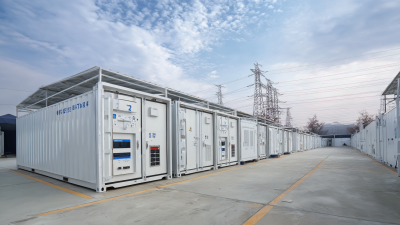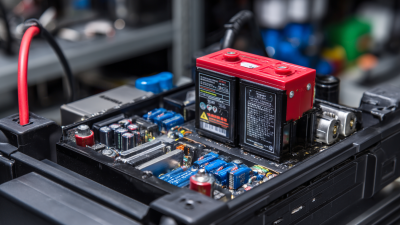Unleashing the Power: Exploring the Future of Eco-Friendly Batteries & More Innovations
In recent years, the global demand for sustainable energy solutions has surged, with eco-friendly batteries & more emerging as a focal point in this transition. According to a report by Grand View Research, the global battery market is expected to reach USD 1.12 trillion by 2027, driven by the increasing adoption of electric vehicles and renewable energy technologies. Innovations in battery technology, such as solid-state batteries and advanced lithium-ion alternatives, promise to enhance efficiency and longevity while minimizing environmental impact.

Additionally, a study from the International Renewable Energy Agency highlights that the implementation of next-generation batteries, alongside energy storage systems, could significantly reduce greenhouse gas emissions across various sectors. As we explore the future of batteries & more, these innovations not only hold the key to revolutionizing energy storage but also pave the way for a more sustainable and eco-conscious world.
The Rising Demand for Eco-Friendly Batteries in the Green Energy Market
The rising demand for eco-friendly batteries signifies a pivotal shift in the green energy market, as consumers and industries alike prioritize sustainability. According to a report by Allied Market Research, the global eco-friendly battery market was valued at approximately $7.42 billion in 2021 and is projected to reach about $14.51 billion by 2030, growing at a CAGR of 8.2%. This surge indicates a growing awareness of the environmental impact of traditional batteries, particularly those containing harmful materials such as lead and cadmium.
Innovations in battery technology, including the development of lithium-sulfur and sodium-ion batteries, are expected to play a crucial role in meeting this demand. The World Economic Forum has highlighted that these advanced batteries not only offer a reduced ecological footprint but also improve efficiency and storage capacities. As manufacturers increasingly invest in sustainable practices, the industry is likely to witness a transformation, paving the way for greener solutions in renewable energy storage, electric vehicles, and consumer electronics. With eco-friendly batteries on the rise, the future of energy storage looks promising, fostering both economic growth and environmental stewardship.
Unleashing the Power: Eco-Friendly Batteries in the Green Energy Market
Projections for the Global Eco-Friendly Battery Market by 2030: Growth and Opportunities
The global eco-friendly battery market is poised for significant growth by 2030, driven by increasing consumer awareness and government regulations aimed at reducing carbon footprints. Innovations in battery technology, such as biodegradable materials and more efficient recycling processes, are paving the way for sustainable energy solutions. Key players in the energy sector are investing heavily in research and development to enhance the performance and longevity of eco-friendly batteries, aiming to meet the rising demand for clean energy storage across various applications, including electric vehicles (EVs) and renewable energy systems.

Projections indicate that the eco-friendly battery market could witness a compound annual growth rate (CAGR) of over 20% in the coming years. The acceleration of electric vehicle adoption, coupled with the growing need for energy storage solutions in residential and commercial sectors, presents lucrative opportunities for manufacturers and investors.
As the technology behind eco-friendly batteries continues to evolve, we can expect not only improved efficiency and reduced costs but also a broader acceptance of sustainable practices in energy consumption, fundamentally transforming how we approach energy storage and consumption in the future.
Innovations in Sustainable Materials: Recycled Components in Battery Production
The transition to sustainable materials in battery production is gaining momentum, driven by innovations in recycling and upcycling techniques. Recent advancements highlight the emergence of recycled components, particularly in electric vehicle (EV) batteries, which are crucial for reducing the carbon footprint of future mobility solutions. For instance, a leading Massachusetts-based recycler is now producing lithium carbonate from recycled EV batteries, paving the way for a circular economy that transforms waste into valuable resources, thereby addressing the growing demand for sustainable battery solutions.
The European Battery Strategy serves as a pivotal framework for promoting sustainability and technological independence within the battery supply chain. By emphasizing closed-loop recycling systems, automotive manufacturers are not only attempting to recover valuable raw materials from high-voltage batteries but are also significantly enhancing the sustainability of their production processes. Reports indicate that effective recycling methods can recover up to 95% of lithium, cobalt, and nickel, supporting environmental goals while ensuring a steady supply for future battery generations. Such developments illustrate a significant step forward in creating eco-friendly batteries that align with global sustainability targets, thereby reshaping the landscape of energy storage and mobility.
The Role of Government Policies in Promoting Eco-Friendly Battery Technologies
Governments around the world play a crucial role in promoting eco-friendly battery technologies, which are essential for a sustainable future. By implementing policies that encourage research and development, subsidies for green technology, and stringent regulations on traditional battery production, governments can significantly drive innovation in this sector. Initiatives like tax incentives for companies investing in sustainable practices and funding for eco-friendly battery research can lead to breakthroughs in performance and recyclability.

Tip: Consumers can also support these initiatives by choosing products that feature eco-friendly batteries or that are designed with sustainability in mind. Look for certifications like Energy Star or products that use reclaimed materials.
Moreover, international cooperation is vital in this endeavor. Countries can share best practices, create standardized sustainability benchmarks, and engage in joint ventures aimed at developing cutting-edge, environmentally friendly battery solutions. This collaborative approach can not only streamline technological advancements but also reduce costs and improve accessibility.
Tip: Stay informed about your local and national policies related to battery technologies. Advocacy for stronger regulations and support for green initiatives can help amplify the demand for cleaner energy solutions.
Emerging Trends: How AI and IoT are Enhancing Battery Efficiency and Longevity
The future of eco-friendly batteries is increasingly intertwined with advancements in artificial intelligence (AI) and the Internet of Things (IoT). According to a report by MarketsandMarkets, the global IoT market in the battery sector is expected to grow from $102.5 billion in 2021 to over $157 billion by 2026, driven largely by the demand for smarter energy storage solutions. AI technologies are enhancing battery efficiency by optimizing charge cycles and predicting energy needs based on usage patterns, ultimately extending battery life. For instance, algorithms can analyze data from IoT devices to adjust how and when batteries are charged, significantly reducing wear over time.
Furthermore, research from the International Energy Agency (IEA) indicates that integration with IoT can lead to improvements in battery recycling processes, making them more sustainable. Smart batteries equipped with IoT capabilities can monitor their own health in real-time, making it easier to identify when a battery is reaching the end of its lifespan. This data-driven approach is essential for advancing circular economy practices in battery usage, allowing for more effective recycling and reducing the environmental impact. As these technologies evolve, the synergy between AI, IoT, and eco-friendly batteries promises a more efficient and sustainable energy future.
Unleashing the Power: Exploring the Future of Eco-Friendly Batteries & More Innovations
| Innovation Type | Description | Efficiency Improvement (%) | Longevity (Years) | Sustainability Index |
|---|---|---|---|---|
| Solid-State Batteries | Utilizes solid electrolytes for improved safety and energy density. | 30% | 15 | 80 |
| Recyclable Lithium-Ion Batteries | Designed for easy recycling to reduce waste and environmental impact. | 25% | 10 | 90 |
| AI-Optimized Battery Management Systems | Uses AI algorithms to enhance performance and predict maintenance needs. | 40% | 12 | 70 |
| Flexible Batteries | Lightweight batteries that can be integrated into clothing and other materials. | 20% | 8 | 60 |
| Lithium-Sulfur Batteries | Higher energy capacity and lower cost, enhancing overall battery performance. | 50% | 10 | 85 |
Related Posts
-

Batteries Delivered Revolutionizing Supply Chains at the 138th China Import and Export Fair 2025
-

Unlocking the Future of Energy Storage Innovations with 12 Battery at the 2025 China Import and Export Fair
-

Unlocking the Benefits: Why Rechargeable Sealed Lead Acid Batteries Are the Future of Power Storage
-

What are the Key Features of Lawn Mower Batteries You Should Know?
-

The Future of Energy Storage Understanding the Science Behind Battery Packs
-

Revolutionizing Yard Care: How Lawn Batteries are Leading the Charge Towards Eco-Friendly Landscaping
